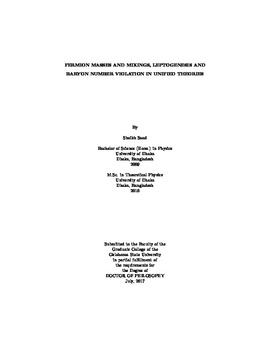| dc.description.abstract | In this dissertation, we study physics beyond the Standard Model (SM) of particle physics to incorporate some of its unexplained phenomenon. Grand Unified Theories (GUTs) are natural extensions of the SM, since gauge coupling unification can be realized in these theories. Also in GUTs, charged quantization can be explained, the hierarchical pattern of the charged fermion spectrum may be understood due to unification of quarks and leptons into same multiplet, extremely small neutrino mass naturally arises via the seesaw mechanism, the cosmological baryon asymmetry of the universe can be explained within the GUT framework and some of the unified theories naturally include Dark Matter candidates. Here, we study several different unified theories that are potential candidates for theories beyond the SM. First we study a class of unified models based on the SO(10) gauge symmetry without the presence of the Higgs in the fundamental 10H representation, as has been used in the literature for most of the SO(10) constructions. Instead, a vector-like fermion in the spinorial representations 16 + 16 is introduced to accommodate flavor mixing. In this new framework, two different non-supersymmetric models and four inequivalent supersymmetric models are studied. This framework provides insights into the fermion masses and mixings. Proton decay branching ratios are also analysed in this context. Then we study a non-supersymmetric SO(10) model and show that the most economic Yukawa sector of such theories consists of a real 10H, a real 120H and a complex 126H Higgs, provided that SO(10) is the only symmetry of the theory. Usual constructions based on non-supersymmetric SO(10) models complexify these Higgs fields, which require additional symmetry exterior to the original gauge symmetry. We show that, with SO(10) being the only symmetry of the theory, a good fit to the full fermion spectrum can be achieved with the economic Higgs sector mentioned above. Furthermore, gauge coupling unification is studied and within this theory the leading proton decay branching ratios are found to be p -> Vpi^+ and p -> e^+pi^0 . Then we study a class of unified models with SU(5) gauge symmetry and follow statistical approach to predict the fermion spectrum from the theory. The Yukawa coupling matrices in this theory are assumed to be non-hierarchical, that is structure-less. The observed hierarchies in the fermion masses and mixings are reproduced with only three parameters of the theory that are assumed to be hierarchical. A detail Monte Carlo analysis shows that, with Yukawa couplings being uncorrelated random variables obeying Gaussian distributions, all observables in the fermion sector can be nicely reproduced. Then we study a minimal partial unified model based on the SU(2)L x SU(2)R x SU(4)C gauge symmetry. A good fit to the full fermion spectrum is achieved, where the seesaw mechanism is responsible for generating neutrino masses and Leptogenesis mechanism can account for the observed cosmological baryon asymmetry of the universe. On top of the gauge symmetry, an imposed global Peccei-Quinn symmetry U(1)PQ solves the strong CP problem and simultaneously provides the axion as the Dark Matter candidate. We also study nucleon decay modes and nuetron-antineutron oscillation in this framework. | |
